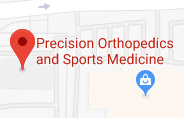 Hand
Hand
Fractures of the hand and fingers
The hand is one of the most flexible and useful parts of our body. In the wrist, many small bones are connected to each other and help you perform various activities.
For more information about Fractures of the hand and fingers, click on below tabs.
Finger Dislocation
Finger dislocation is a condition in which the bone of your finger has moved away from its normal position. Dislocation can be caused from jamming or overextending the finger during sports activities, or during a fall with an outstretched hand.
For more information about Finger Dislocation, click on below tabs.
Finger & Thumb Sprains
Injuries that involve tearing or stretching of the ligaments of your fingers is termed a sprain. Sprains in the fingers are most often caused from a fall when you extend your arms to reduce the impact of the fall, or from overuse or repetitive activity of the thumb such as with texting.
For more information about Finger & Thumb Sprains, click on below tabs.
Tendon injuries
Tendons are the bands of fibrous connective tissue that connect muscles to bone. Tendons aid in the movement of the fingers, hand and all other body parts.
For more information about Tendon injuries, click on below tabs.
Mallet Finger
Mallet finger is a condition where the end of the finger is bent and does not straighten. It occurs when the extensor tendon on the back of the finger is damaged. The finger joint is a hinge-joint that allows bending and straightening of the fingers.
For more information about Mallet Finger, click on below tabs.
Trigger Finger
The tendons of the thumb and each of the fingers pass through a sheath on the palm side of the hand. Certain diseases and overuse activities can cause a thickening of this sheath. As the tendon passes through a thickened sheath, the tendon eventually becomes irritated and swells. Pain, catching and eventually locking of the finger will occur. Early treatment consists of anti-inflammatory medication or Cortisone injection. If these fail to provide relief, the sheath is opened surgically through a small incision at the base of the finger.
Dupuytren’s Contracture
This is a disorder of thickened ligament in the palm, resulting in nodules on the ligament; which if severe enough can cause an inability to fully straighten the fingers. The ring and small fingers are most commonly affected.
The cause of this disorder is unknown. It is seen more commonly in men and is usually found in individuals of Northern European extraction.
If deformity is mild and there is no functional loss, no surgery is needed. If, however, there is significant contracture that interferes with full use of the hand, surgical removal of a portion of the ligament is the treatment of choice to improve function and to prevent further deformity.
For more information about Dupuytren’s Contracture, click on below tabs.
Artificial Finger Joint Replacement
Finger joints are essential for many activities, and arthritis in this area can cause significant joint damage and deformity. Artificial finger joint replacement is a surgical procedure that involves the removal of an arthritic or damaged finger joint and replacement with an artificial prosthesis.
For more information about Artificial Finger Joint Replacement, click on below tabs.
2120 N. MacArthur Blvd
Suite 100
Irving, TX 75061
 Ph: (972) 438 4636
Ph: (972) 438 4636
 Fax:
(972) 438 2077
Fax:
(972) 438 2077

 Make an Appointment Online
Make an Appointment Online

 Shoulder
Shoulder Elbow
Elbow Wrist
Wrist Patient Education
Patient Education Testimonials
Testimonials Map
& Location
Map
& Location Patient Forms
Patient Forms






